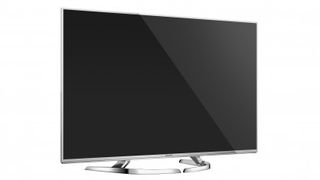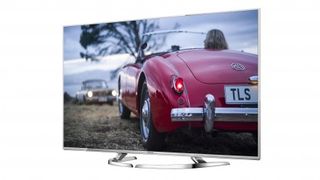Why you can trust TechRadar
For much of the time the images on the 50DX750's screen look nothing short of beautiful, punching well above the set's price point. In fact, even if you only use it with standard dynamic range content, the set sits comfortably in 'best buy' territory.
It's one of the few instances where, once you've reduced the 50DX750's backlight setting considerably - potentially to around a third of its maximum level if you're watching a film in a darkened room - standard dynamic range Blu-rays and HD broadcasts benefit from a terrific black level response for such an affordable but well-featured TV.
Being able to deliver an impressively true black colour relatively untarnished by the grey mist effect you get with pretty much all edge-lit LCD TVs, to some extent, makes dark scenes look believable, immersive and much more consistent with bright ones when it comes to tone and depth.
What's more, so long as you've followed the earlier advice regarding the backlight setting, the impressively rich, deep blacks are delivered with strong consistency right across the screen, with only the very faintest traces of the backlight clouding problems many edge LED TVs suffer from.

Even better, the really impressive black levels are delivered without coming at the usual cost of lost shadow detail in the darkest areas. I can't think of another LCD TV brand that's quite as good as Panasonic at retaining tiny bits of luminance and colour information in dark areas - a testament, in part at least, to the excellent processing systems Panasonic has delivered for the past few years.
The same deftness of touch is apparent with the 50DX750's handling of colours when showing standard dynamic range content. So good is it at picking out the slightest tonal shifts, balancing the whole colour palette and making colours always look natural and believable, that it's hard to believe it's using an 8-bit panel. It's impressive to see, too, that the 50DX750 is able to deliver all these subtle colour traits while still delivering rich saturations and plenty of vibrancy.
In other words, the 50DX750 seems to put some of the hardware and software developed for HDR to good use in enhancing SDR, without leaving the latter looking in any way unnatural.
Impressive clarity and colour
Having such pristine control over its light and colour performance also helps the 50DX750 deliver a good sense of 4K UHD's clarity and detailing, despite some marginal motion blur taking the edge off things when there's a lot of motion in the frame. Actually, the 50DX750 delivers a fine sense of sharpness and texture with HD sources too, thanks to an excellent upscaling performance.
This same processing engine also does a surprisingly decent job of the actually very difficult task of trying to convert SDR footage to something approaching HDR via assorted remastering options.
The way the set can expand SDR's colour range without images starting to look unnatural or forced is particularly impressive. Having said all that I'd probably still avoid the remastering circuitry with most SDR sources, and leave the TV's HDR capabilities to genuine HDR sources.
Speaking of which, in many ways the 50DX750's HDR performance is better than I'd expected given that it makes no claim to deliver HDR to the standard recommended by the UHD Alliance.
Feeding the TV an array of Ultra HD Blu-rays reveals a comfortably more expansive colour range than you get with SDR versions of the same movies, and there's also an expanded sense of contrast, with slightly deeper blacks and clearly brighter light peaks.

The general brightness level of some HDR scenes is higher too, though the 50DX750's edge LED engine doesn't score as well in this general HDR brightness department as the direct-lit DX902 models.
Also good to see is how well the 50DX750's processors remap HDR images to the screen's sub-1000 nit brightness capabilities, as it largely ducks the lost shadow detail, unnatural colours and flared-out white areas issues you can get with less astute remapping systems.
In keeping with many other 2016 HDR TVs, though, the 50DX750's HDR abilities come up a bit short during dark scenes – or, more specifically, dark scenes that contain a few bright highlights.
The issue is simply that you can clearly see a band of light running down the picture around any bright objects during dark HDR scenes when using the TV's optimised HDR settings.
A smaller HDR distraction sees the image's overall brightness flitting up and down a bit distractingly when you've got the TV's Adaptive Contrast feature selected. Yet, if you turn this feature off, overall black levels take a significant hit I suspect most users won't want to put up with.

There are mitigating circumstances with the 50DX750's HDR dark scene issues. For a start, they aren't as consistently obvious if you're watching TV in a reasonably bright room. They're also less obvious if what you're watching has a roughly 16:9 aspect ratio, so that there are no black bars above or below the picture. Finally, you can reduce the obviousness of the backlight flaws if you reduce the backlight setting when watching HDR content.
However…
For me, though, HDR movies are actually made for dark room viewing at least as much as SDR movies are. Also, the vast majority of popular movies are made with aspect ratios that require the addition of black bars above and below them. And, finally, the more you reduce the TV's brightness output the more you're reducing the TV's HDR impact and accuracy.
It's important to stress that HDR playback thrills on the 50DX750 far more than it aggravates. So much so that many may consider the dark scene backlight flaws a fair price to pay for all the good stuff. But movie fans who hate ever being distracted out of what they're watching could well find the HDR backlight issues at least a little frustrating.
The 50DX750's 3D performance, finally, is sadly pretty uninspiring. While the screen's brightness and colour richness serve it well in countering the dimming effects of active shutter glasses, 3D images suffer with quite significant amounts of crosstalk ghosting. This reduces the sharpness of 3D images and makes them quite tiring to watch.
Current page: Performance and picture quality
Prev Page Introduction, design and features Next Page Usability, sound, value and verdictJohn has been writing about home entertainment technology for more than two decades - an especially impressive feat considering he still claims to only be 35 years old (yeah, right). In that time he’s reviewed hundreds if not thousands of TVs, projectors and speakers, and spent frankly far too long sitting by himself in a dark room.

I'm off to France this summer, and this app could make me très fluent

Intel unveils flurry of new Arc GPUs — however serious graphics users will have to wait for more powerful models, as these focus on a completely different and more lucrative market

We just got another hint that the Samsung Galaxy Watch 7 is almost here

